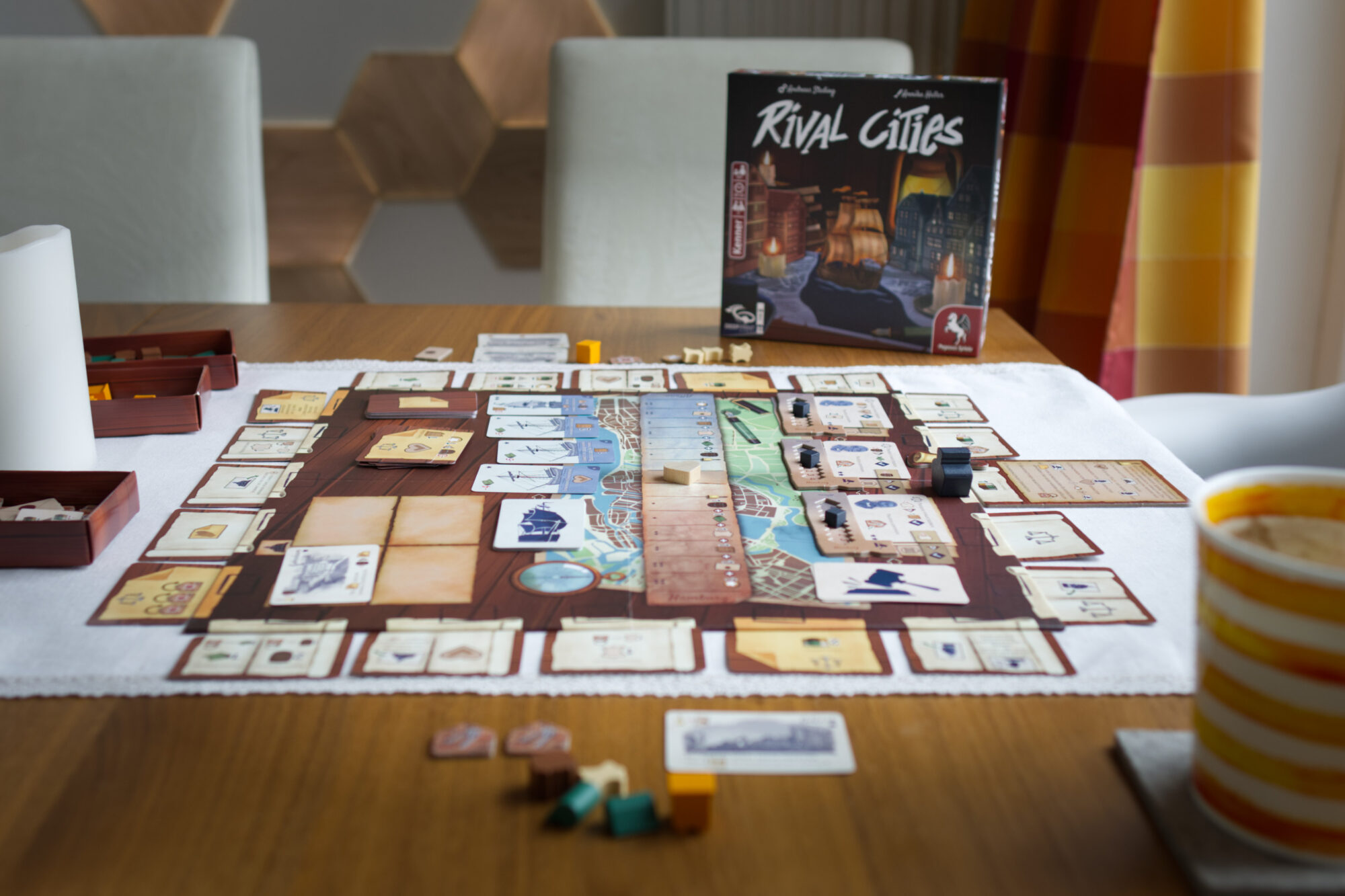Sometimes a game just hits you. It scratches an itch you didn’t know you had, like when I first played Horseless Carriage and its spatial puzzle just completely fried my brain. It was too complex a system for me to understand, too many things to think through, and so I gave up, had fun, and loved it. Or when I first played Fantasy Realms, lost my first game horribly, and said “let’s do this again right now!”. For some reason, Rival Cities scratches such an itch for me …
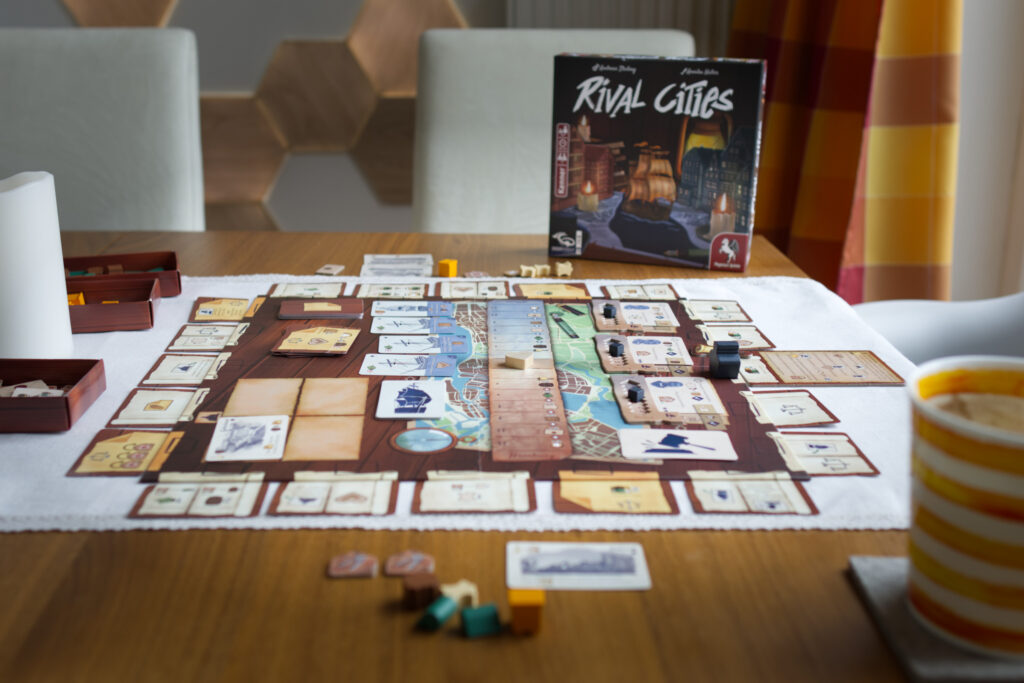
Setup
Unboxing Rival Cities already holds its first pleasant surprise: lifting the rules and 4-panel board out of the box doesn’t reveal an insert but a set of tug boxes stylized as crates and neatly arranged. No loose components, no ziplock bags, no plastic wrapping, just four thematic storage units. Neat!

Setup takes a moment, but it’s not too bad. There are standard action cards that get shuffled and arranged around the board, a deck of one-time bonus action cards is placed on the board and a few of them placed into the remaining gaps around the board. Then there are cards to represent court cases, partner cities, and ships of which each only a subset is used during each play for some added replayability. To finish setup, each player gets a few starting resources and a heart is placed right in the middle of the long popularity track that is central to the board. For a game of this box size, it immediately becomes apparent that a lot more than expected is going on here.
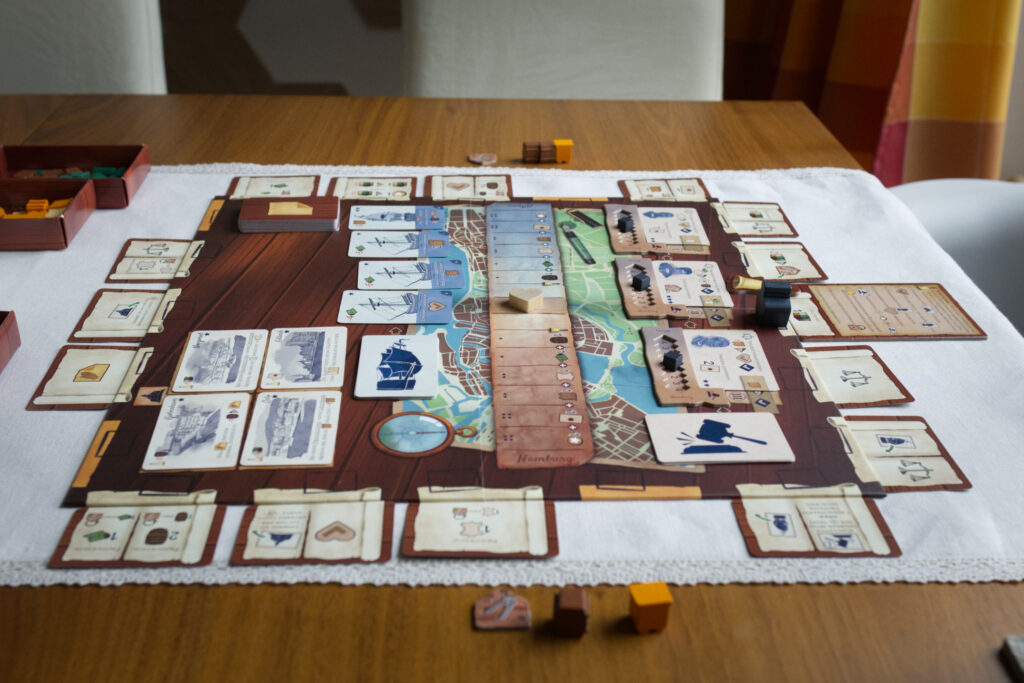
The ongoing court cases in particular are worth highlighting for two reasons: first, they are the timer of the game and when after seven rounds the last one has been adjudicated, the game ends. The other aspect is that for each of the three cases currently going on, a small cardboard track and a cube is placed next to them to indicate in which player’s favour the courts currently lean. They are also the only minor gripe I have with Rival Cities otherwise excellent production: it’s a little bit fiddly to slide them down the line as new cases get revealed and since the values of those tracks are printed on the board and not on the track, it is critical to align them exactly to avoid incorrect readings. It might look nice, but it would have been that much more practical to have the numbers printed not the cardboard pieces themselves.
Everything else about Rival Cities is top notch though, especially for a game at this low a price point (here in Germany, I found one retailer selling it for as low as 25€). The wooden resource components are nice and chunky, the card illustrations lovely, the board looks great and moody.

A Small Thematic Detour
In Rival Cities, both players compete in the historic rivalry between the city of Hamburg, Germany, and its neighbor Altona. I actually live in Hamburg and have therefore of course heard of this particular piece of local history. What is now part of the same city was at some point a major city on one side (=Hamburg) and on the other a neighbouring fishing village with a tavern. Because said tavern was outside the city bounds and thus not subject to the same taxes, it was cheaper to go there then get drunk in the city. Hence the Hamburgian tavern owners said it was “all zu nah“ (=way to close) from which the name Altona is said to have derived. As both village and city grew, the rivalry remained and even nowadays Altona—which has been merged into Hamburg—still has an air of being the “cool underdog” part of the city.
Hearing about the backstory, it would be natural to assume that the prominently featured population track would be the singular victory criteria in the game, but that is not so. There are actually five dimensions at work at the same time and a player can win using either criteria. But more on that later.
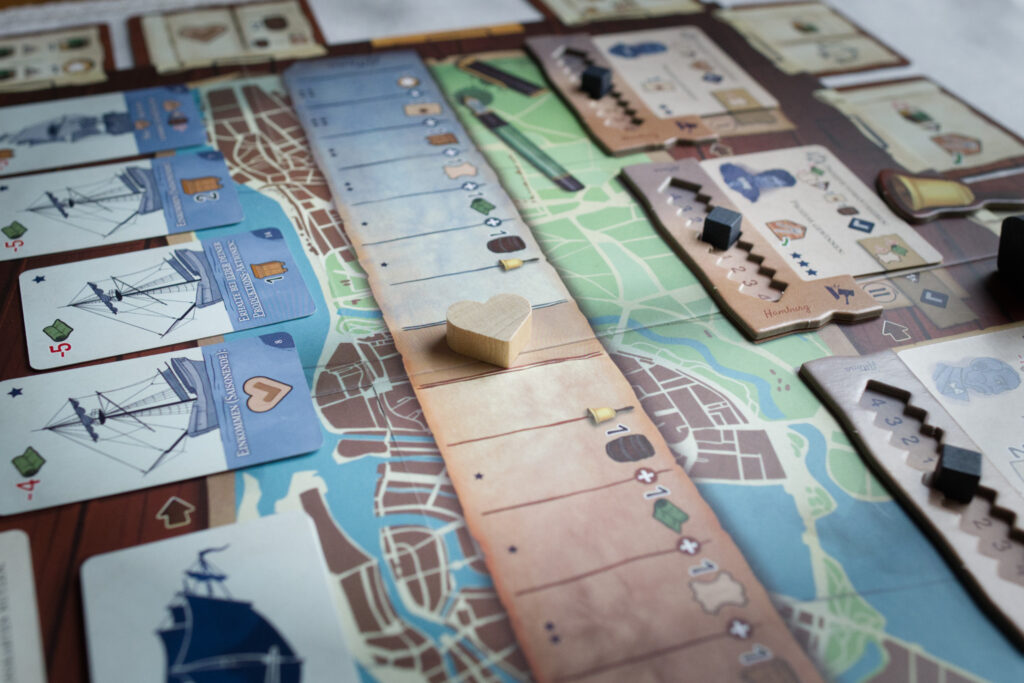
The Turn
When it’s a player’s turn, they check where the large black inkwell token is on the outside track around the board, simply move it forward in a clockwise direction, and then perform the action represented there. The first two steps are for free, the next two cost one resource each, and then two additional resources for every step beyond that.
The number of different types of actions is quite astonishing, but they are all pretty straight forward and thus easy to teach. There are multiple production actions that let players flip their factories to produce one of the 4 resources of the game. Another lets the player pick up one of the four partner cities which cost upkeep but provide unique powers. And here comes the first of five (!) win conditions: if a player ever manages to get all four, the game immediately ends and that player is crowned victor. So one has to be cautious when the opponent has managed to already gather two or even three and steal them back.
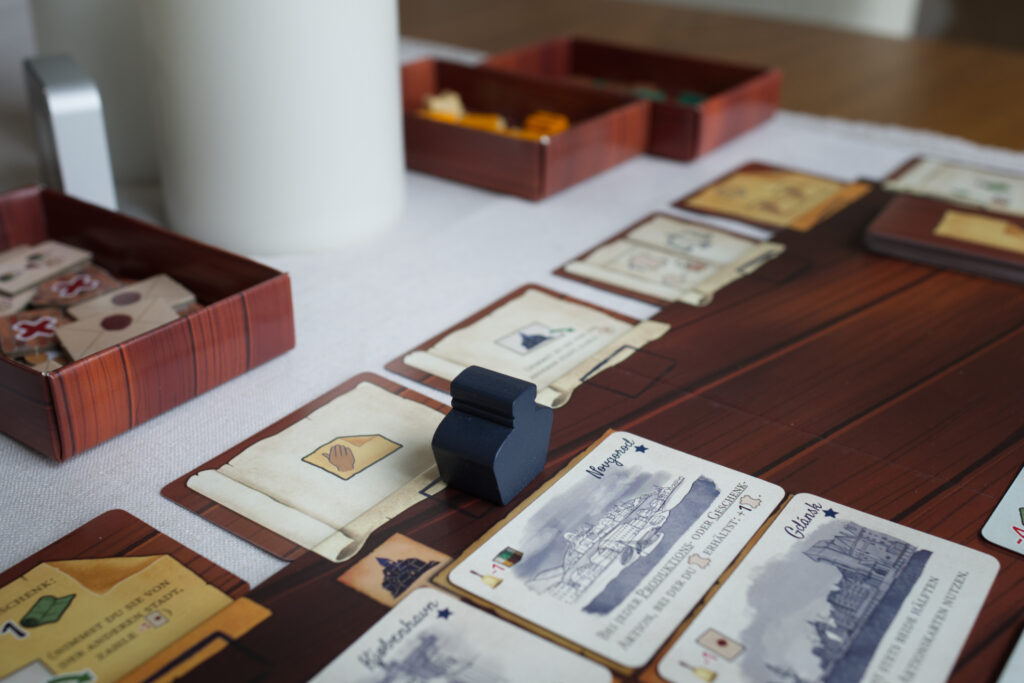
Ships are another dimension. They are simply purchased and cannot be taken away by the other player, so the instant win condition is to have three more than the other player. Do that, and again the game ends immediately. Ships cost 3-5 of one type of resource or the other and range in doing nothing to giving the player permanent effects. Then there are actions that show a heart symbol which translates into moving the popularity track marker one space towards that player and if it reaches one end of the track, you guessed it, the game immediately ends.

The court case action is the most complex one to explain. There are always three in play and once the ink well hits a certain spot of the board, the “season” is over and the case in the first slot gets decided. If it is only one tick in favour of either player, that player gets a star token (more on those later), but if it is two or more spaces towards a player, that player gets the card plus the instant reward printed on it. This time, having three in total (not three more than the opponent) insta-wins the game.
The court cases however are also sort of a resource exchange. Taking the court action allows that player to trade in the resources shown on a case to get an immediate bonus, typically in the form of a resource or heart symbol. So one isn’t just moving a marker on a track but also can do a bit of resource/action conversion. This is in particular interesting because all actions are only represented in limited number around the board. Missed that one action spot with a heart symbol on it that would allow you to pull popularity back into your direction? Better hope there is currently a court case in play that gives rewards with hearts or you won’t be able to change popularity again this round.
The rotating selection of court cases thus produces a nice changing emphasis based on what rewards are to be gained in that round. If there is a court case that for example rewards with hearts, that might be your chance to push for a popularity win that will be much harder once that case is adjudicated and taken off the board. If there is instead one that awards cloth, it might be the right time to invest in ships.
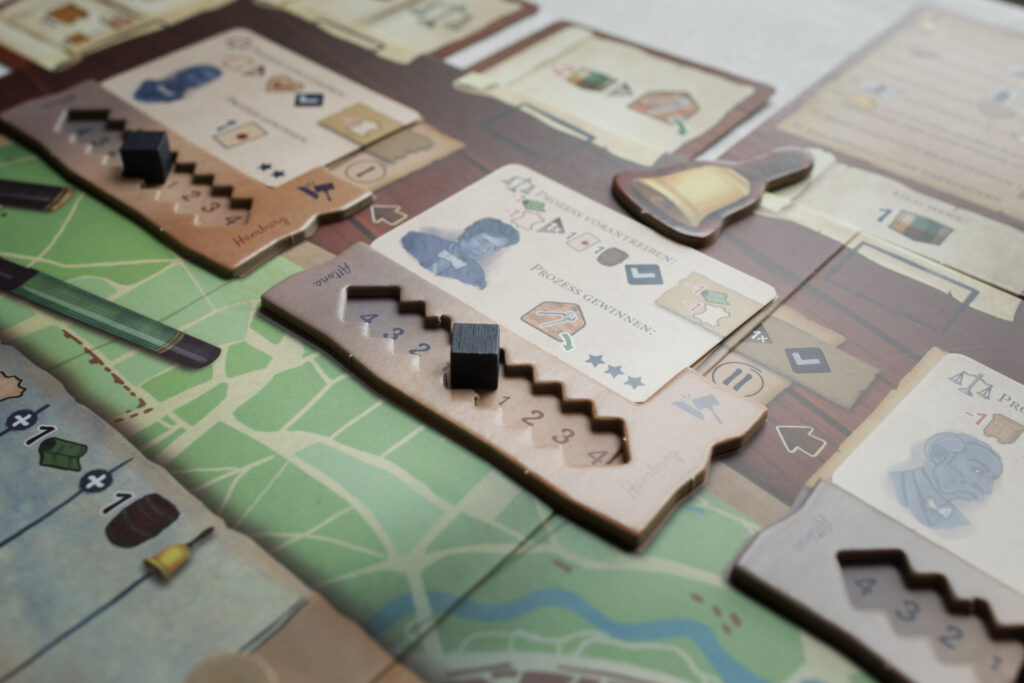
End of Season
Once the inkwell has gone around the board, gameplay is interrupted and the end of season phase is executed. During it, the player with the most ships gets an additional point in popularity, the person with the most popularity might get free resources depending on how far popularity is in their favour, the oldest court case is processed, and a few other things happen. It’s a multi-step process, but not tedious at all thanks to the large player aid that is placed where usually an action card would be. There is even a cute little bell token that is given as a reminder to the player whose turn it is because end of seasons happens after movement but before that player is allowed to do the action they moved on.

Game End
After a maximum of 7 rounds—when the last case is done—the game also ends and a totally different criteria becomes relevant: hearts. All court cases, ships, and partner cities feature 1-4 stars and the player that got the most of them wins. So it’s a viable strategy to not over-extend in any of the four dimensions, just invest enough effort to prevent the other player from winning, but pick up cards with more stars on them than whatever the other player got while trying to rush it.
Together with the action selection mechanism (and a few more action types I haven’t even mentioned), this creates an interesting push and pull: the other player got their second boat? Better make sure you’re the person that can reach the next ship action first and thus reduce their lead. Or push even harder on that other criteria you were going for. Sometimes offence is the best defence. At other times, one better just tries to even things out again and win by stars after the seventh round.

Conclusion
Rival Cities is ultimately a simple game, even if the number of actions / symbols that have to be explained are a bit daunting at first: move inkwell, do action, get or pay resources, pick up ships / cities or invest in court cases / popularity. Try to sneak by your opponent in one of the criteria while not risk losing yourself in another. And try to move the inkwell in a way that you get the currently most opportune actions for free while your opponent has to spend resources to move the inkwell to something useful to them.
What Rival Cities does though is to use those simple mechanisms and turn them into a multi-dimensional tug of war. Even if it’s only the first round of the game and you’re the second player, you’re effectively one step behind in whatever the other player is trying to achieve. Reading the board and what action types are where becomes of the essence. For example, I had a session in which there was a stretch of a board length and a half where there was not a single resource production action. So I had to pace myself and plan a little bit ahead before entering into that stretch.
In another session, the friend I was playing against right out of the gate pushed hard for popularity and it was too late when I realised that for the whole rest of the round and up to the season end, there were no other actions to get hearts. All of them had been within the first few steps after the starting space. This was a particularly clever move because the popularity track provides those free resources during season end if a player manages to pull the heart token far enough towards them, and he got lots of them that round! I thought I could as well forfeit the game right then and there but then I saw an opening and I was able to pick up two ships rather quickly. It would take a while until the inkwell would get close to another ship action, so he couldn’t do anything to reduce my lead in ships and by the time the action came within reach, I had picked up a one-time action card that allowed me to buy a ship myself and win. It was glorious.

Rival Cities all boils down to a singular question: how far should that inkwell move? Do you take the first or second action so you get it for free? Invest resources to move further? Pick up one-time use cards even if it costs you a turn to be more flexible later on when you reach a section where all the standard actions don’t help you? Move one step less so your opponent can’t reach a spot further down the line or one step more so you went past the action one they really wanted? It’s hard to describe, but the dynamic of the game is quite astonishing.
To sum it up, Rival Cities fires on all cylinders and punches above its weight class. It looks good and plays well, comes in a small box, and has lots of replayability built in. The number of different actions to learn could prove a bit off-putting for casual players, but it’s all really quite intuitive once one has played a round. The only thing missing to make it perfect (ignoring the slight fiddlyness of the court case tracks) would have been a solo mode included in the box. But I started designing my own to remedy that and I’m happy to report it already plays surprisingly well. So if you like small box 2p-only games with a bit more meat on the bone such as Agricola: All Creatures Big and Small, Splendor Duel, or Caper Europe, you’re gonna like this one. It’s a charming little game and it has quickly become my go-to (replacing Caper Europe in my list of recommended games) when I want that cosy-but-competitive vibe in a 30-45min format.
